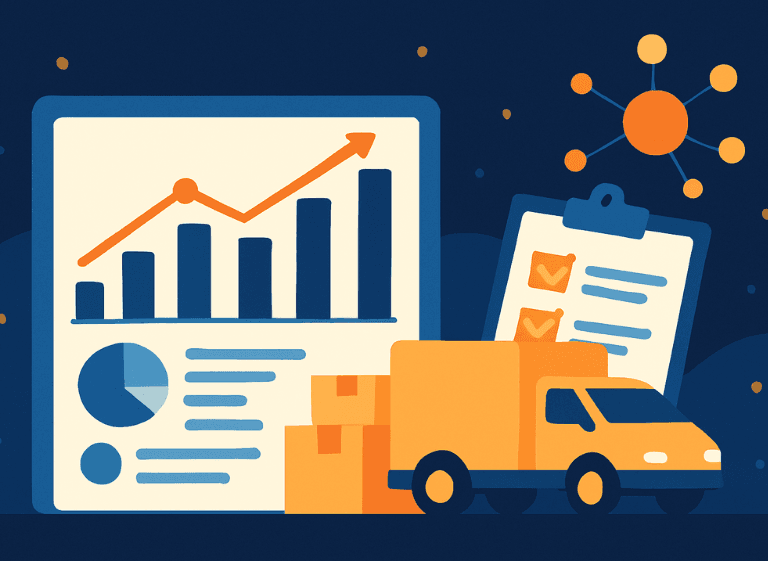Performance optimization
Real project examples
Data analytics
Big data
AI tools
Data-Driven Logistics: How Real-Time Reporting and Analytics Drive Growth
Nadiia Sidenko
2025-04-28
When a shipment arrives late because of an unforeseen disruption, the damage isn't just measured in hours — it’s measured in lost customers and broken trust. In logistics, delays and blind spots are silent killers of growth. That’s why data-driven logistics, powered by predictive analytics, real-time data analytics, and supply chain analytics, has become essential. Companies using predictive analytics tools and smart data analytics solutions don't just respond to problems — they anticipate them, minimize risks, and consistently outperform competitors.

Predictive Analytics in Logistics: How Data Shapes Modern Supply Chains
Predictive analytics has transformed the logistics landscape, offering companies the ability to anticipate changes before they occur. By analyzing historical patterns alongside real-time information, businesses can accurately forecast demand fluctuations, manage risks, and optimize inventory movements.
Understanding the Shift from Manual Forecasts to Data-Driven Predictions
The era of relying on manual spreadsheets and intuition is over. Traditional forecasts based solely on past performance often miss the nuances of volatile markets. Predictive analytics empowers businesses to:
- Forecast seasonal trends more accurately
- Predict potential supply disruptions
- Optimize resource allocation well in advance
Comparison of Forecasting Methods:
| Criteria | Manual Forecasting | Predictive Analytics |
|---|---|---|
| Data Sources | Past sales data only | Real-time + historical data |
| Accuracy | Low to moderate | High |
| Adaptability | Low (static) | High (dynamic) |
| Reaction Time | Delayed | Immediate |
This transition allows companies to adopt proactive strategies, significantly improving service levels while reducing operational costs.
Key Benefits of Real-Time Data Processing for Supply Chain Management
Real-time data analytics is a game-changer in logistics. It provides organizations with instant visibility into inventory levels, shipment statuses, and supplier performance, allowing faster adjustments and better outcomes.
From Delayed Reports to Instant Reactions: Why Speed Matters
Speed is no longer a competitive advantage — it is a requirement. According to McKinsey, companies utilizing real-time supply chain visibility can improve order fulfillment rates by up to 30% and reduce logistics costs by 15%. Immediate access to live data empowers businesses to:
- Reroute deliveries around sudden disruptions
- Manage stock levels more efficiently
- Avoid production halts due to delayed materials
A supply chain that reacts in minutes, not days, secures customer loyalty and preserves profitability.
Building Smart Dashboards: Turning Complex Data into Clear Decisions
Managing millions of data points manually is impossible. Smart dashboards make it manageable by highlighting the most critical KPIs at a glance, helping decision-makers focus on what truly matters.
Essentials of Actionable Analytics for Operational Efficiency
An effective dashboard should prioritize clarity and actionability. Key supply chain analytics metrics to track include:
- Inventory turnover ratio
- Forecast accuracy
- Order cycle time
- On-time delivery rate
- Transportation cost per unit
Without a clear visualization of these metrics, valuable insights often remain hidden, leading to missed opportunities or costly mistakes. For instance, a delay in identifying low stock levels can result in expensive stockouts — a risk easily avoided with a well-designed dashboard.
Choosing the Right Tools for Predictive Supply Chain Analytics
Choosing predictive analytics tools can make or break the success of a logistics analytics strategy. The market is rich with options, but not all platforms offer the flexibility and intelligence modern supply chains demand.
Features to Look for: Scalability, AI Capabilities, Real-Time Updates
When selecting data analytics solutions, businesses should prioritize platforms that offer:
- Scalability to accommodate growing operations
- AI capabilities for advanced predictive modeling
- Real-time data updates for responsive decision-making
- Customizable dashboards for tailored insights
Successful companies often leverage predictive analytics insights by integrating big data in logistics, gaining the ability to foresee disruptions, manage inventory with precision, and optimize the entire supply chain.
Case Study: How Leads Otter Uses Real-Time Data to Optimize Client Targeting
A practical illustration of real-time analytics success can be found in a client-targeting platform optimized for immediate action based on live data streams.
By implementing real-time processing and smart alerting mechanisms, the platform reduced reaction times to leads by over 40%, dramatically boosting conversion rates.
In logistics, this principle applies equally: real-time monitoring of shipments, warehouse stock, or transportation routes enables businesses to react instantly, avoiding costly disruptions.
The approach seen in this case study underscores the critical role of instant insights and proactive response strategies in supply chain success.
From Data to Business Impact: How to Build a Predictive Analytics Strategy
Turning predictive analytics into tangible business value requires a structured, phased approach. It’s not just about technology — it’s about strategic implementation.
Roadmap for Implementation: Pilot, Scale, Optimize
- Pilot: Identify a high-impact, manageable area within the supply chain and apply predictive analytics on a small scale.
- Scale: Expand successful models to broader logistics operations, integrating them with ERP and CRM systems.
- Optimize: Continuously refine predictive models based on new data and changing business goals to maintain supply chain optimization.
A common mistake is rushing into large-scale deployments without proper piloting. A careful, phased rollout ensures maximum value from your predictive analytics investments.

Conclusion
Mastering data-driven logistics requires much more than installing predictive analytics tools. It demands strategic thinking, expert knowledge, and a tailored implementation plan based on real-world experience.
Attempting to navigate this complex journey without seasoned technical partners can lead to underwhelming results, missed opportunities, and unnecessary costs.
Pinta WebWare brings proven expertise in real-time data analytics, predictive modeling, and supply chain optimization, helping businesses turn data into lasting competitive advantages.